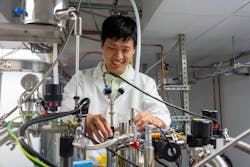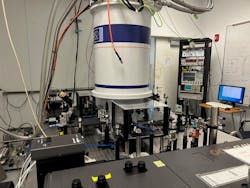Scientists observe quantum vacuum phenomenon theoretically predicted >50 years ago
Rice University scientists recently reported a direct observation of an elusive quantum phenomenon theoretically predicted more than 50 years ago—and it opens a new frontier in quantum materials research.
The superradiant phase transition (SRPT) has intrigued physicists for decades because it represents a profound type of quantum phase transition driven purely by collective coupling between quantum vacuum fluctuations and materials (see video).
“Despite its theoretical prediction more than 50 years ago, until now, SRPT was never achieved within a material at equilibrium,” says Dasom Kim, a postdoctoral research associate in Junichiro Kono’s Lab. “I was inspired by the challenge of observing this elusive phenomenon by engineering quantum fluctuations themselves—without the need for external lasers or strong fields.”
Quest for SRPT
On their quest to observe SRPT, the team explored rare-earth orthoferrite (ErFeO3), a magnetic crystalline material where two types of spin excitations—iron (Fe3+) spin waves (magnons) and erbium (Er3+) spins—interact strongly.
The scientists cooled the crystal down to -457°F, and then applied a static magnetic field of up to 7 tesla (more than 100,000x stronger than Earth’s magnetic field). “We precisely tuned the material parameters to observe the SRPT,” says Kim. “Importantly, we used terahertz and gigahertz spectroscopy only as passive probes—no strong external fields were applied to the system. Our careful approach ensured that the transition we observed was a purely equilibrium phenomenon driven by quantum fluctuations intrinsic to the material.”
They used terahertz time-domain spectroscopy and broadband gigahertz spectroscopy as noninvasive probes to monitor low-energy excitations within the material. These techniques enabled detection of spectral changes with extremely high sensitivity while ensuring the system remained undisturbed. “The precision of these passive measurements was crucial,” Kim points out. “They allowed us to track the transformation of the collective modes in real time—without introducing external perturbations that could mask the equilibrium-driven nature of the transition.”
To pull it off, the team varied the magnetic field to control the interaction between the Fe3+ magnons and Er3+ spins. “Near a critical point, the hybridized collective modes underwent a dramatic transformation: One mode softened to zero energy, while another exhibited a sudden energy jump,” Kim explains. “These spectral signatures directly confirmed the ground state of the system had reorganized into a new phase triggered entirely by quantum fluctuations at equilibrium.”
A new frontier in quantum materials research
The team’s results show that quantum fluctuations can be a powerful tool to control material phases—and it opens a new frontier in quantum materials research. Instead of relying on heat, light, or chemical modifications, phase transitions can be driven by engineering vacuum fluctuations.
“Crucially, at the SRPT critical point, we theoretically achieve perfect intrinsic squeezing, where quantum noise in a particular observable is fully suppressed,” Kim says. “This naturally occurring squeezing could be used for passive noise correction in quantum computing and sensing—improving fidelity and precision without requiring complex active control systems.”
Achieving the desired material purity and precisely controlling the experimental conditions were critical. “We had to ensure that all probes remained weak enough to avoid disturbing the equilibrium quantum state,” he says. “Disentangling the SRPT signatures from conventional magnetic behavior required not only sensitive measurements but also detailed theoretical modeling and careful interpretation.”
The most exhilarating moment of this work was “observing the spontaneous softening of a mode to zero energy, signaling that the quantum vacuum fluctuations alone had driven the system into a new ground state,” Kim adds. “It was deeply satisfying to see experimental proof of a phase transition arise not from heating or external forcing but purely from the engineered strength of the quantum vacuum itself.”
What’s on the horizon for SRPT?
While still at the fundamental research stage, Kim says the ability to induce phase transitions via engineered quantum fluctuations—and to access ground states with perfect intrinsic squeezing—holds exciting technological implications.
Potential applications include ultralow-noise quantum memory, passively error-corrected quantum computing, and quantum sensors operating at the fundamental noise limit. “With continued progress, we envision initial applications beginning to emerge within the next 10 to 20 years,” he says.
“Our next major step is to directly measure the ground-state squeezing associated with the SRPT using newly developed ultrafast optomagnonic techniques,” says Kim. “We’re also exploring whether similar equilibrium-driven quantum phase transitions and stable squeezed states can be achieved within other materials and systems. Ultimately, we aim to build scalable, solid-state platforms where quantum squeezing becomes a robust and practical quantum resource.”
FURTHER READING
D. Kim et al., Sci. Adv., 11, 14 (Apr. 4, 2025); https://doi.org/10.1126/sciadv.adt1691.
About the Author
Sally Cole Johnson
Editor in Chief
Sally Cole Johnson, Laser Focus World’s editor in chief, is a science and technology journalist who specializes in physics and semiconductors.


